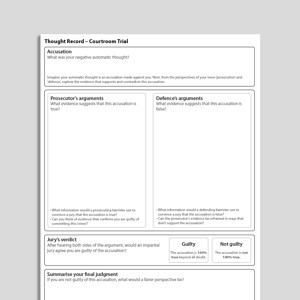Prompts For Challenging Your Negative Thinking
Cognitive restructuring is an evidence-based intervention that involves identifying, evaluating, and modifying maladaptive cognitions, including negative automatic thoughts (NATs). The Prompts For Challenging Your Negative Thinking information handout is designed to guide clients through the process of evaluating negative automatic thoughts. It presents questions that help clients explore whether their negative thoughts are accurate, helpful, objective, and fit with the ‘bigger picture’.
Download or send
Related resources
Tags
Languages this resource is available in
Techniques associated with this resource
Mechanisms associated with this resource
Introduction & Theoretical Background
Beck’s cognitive model (Beck et al., 1979) proposes that events are not directly responsible for the way we feel. Rather, it is the interpretation of those events – our appraisals, thoughts, or cognitions – that generates emotional responses. The model implies that we can change how we feel by changing how we think.
The CBT model describes different levels of cognition that underpin how we think about ourselves, other people, and the world, shaping our interpretations of events and how we respond to them. Moving from the deepest to the most superficial, these are:
- Core beliefs. These are understood as deep-rooted, global, and absolute judgments (e.g., “I am competent”, “No one can be trusted”, “The world is dangerous and unpredictable”).
- Intermediate beliefs. These are understood as assumptions that guide behavior across situations. They are often stated in a conditional ‘if-then’ format (e.g., “If someone is nice to me, then
Therapist Guidance
"People have hundreds of automatic thoughts every day that just ‘pop’ into their mind, but they aren’t always accurate. Sometimes our thoughts are correct and sometimes they are just opinions or best guesses – some therapists say, “You can’t believe everything you think”. Either way, they affect how you feel and behave. Noticing and examining your automatic thoughts can help you to see things more accurately, which can help you feel better. Would you be willing to look at this together?"
Additional guidance:
- Encourage the client to use this resource to examine negative thoughts soon after they have arisen, while their memory is fresh.
- If the client identifies multiple thoughts, prompt them to work on one thought at a time. In the case of images, ask the client to reflect on what the image means to them.
- Encourage the client to work through all the questions in the handout.
References And Further Reading
Beck, A. T. (1963). Thinking and depression: I. Idiosyncratic content and cognitive distortions. Archives of General Psychiatry, 9, 324-333. DOI: 10.1001/archpsyc.1963.01720160014002.
Beck, A. T., Rush, A. J., Shaw, B. F., & Emery, G. (1979). Cognitive therapy of depression. Guilford Press.
Burns, D. D. (2022). Feeling great: The revolutionary new treatment for depression and anxiety. PESI.
Ezawa, I. D., & Hollon, S. D. (2023). Cognitive restructuring and psychotherapy outcome: A meta-analytic review. Psychotherapy, 60, 396–406. DOI: 10.1037/pst0000474.
Leahy, R. L. (2017). Cognitive therapy techniques: A practitioner’s guide (2nd ed.). Guilford Press.
Lorenzo-Luaces, L., German, R. E., & DeRubeis, R. J. (2015). It’s complicated: The relation between cognitive change procedures, cognitive change, and symptom change in cognitive therapy for depression. Clinical Psychology Review, 41, 3-15. DOI: 10.1016/j.cpr.2014.12.003.
Shafran, R., & Rachman, S. (2004). Thought-action fusion: A review. Journal of Behavior Therapy and Experimental Psychiatry, 35, 87-107. DOI: 10.1016/j.jbtep.2004.04.002.
Vassilopoulos, S. P., &





